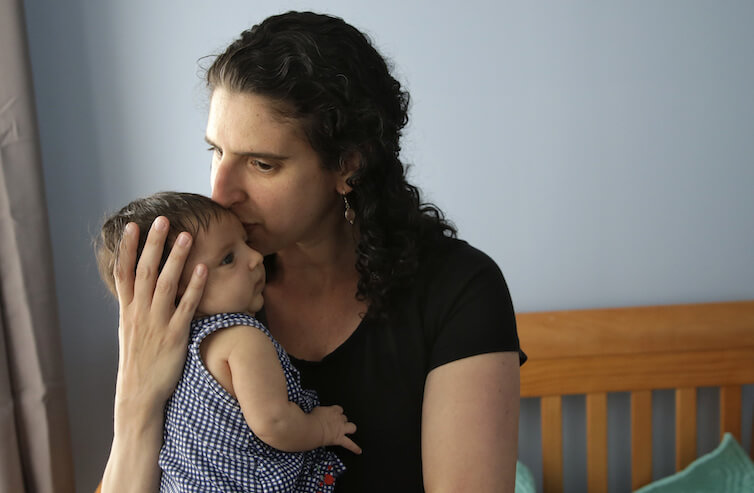Modernizing U.S. paid family leave for 21st century families

Women now make up almost half of the U.S. workforce and more than half of the U.S. population. Despite the central role women play in the economy, our labor laws and institutions do too little to address the various ways in which women are held back at work. This not only hampers women’s economic well-being, but also has implications for U.S. productivity, labor force participation, and economic growth.
Download FileModernizing U.S. paid family leave for 21st century families
Luckily, there are models that federal policymakers can look to as they consider options for designing paid family leave. In our paper for the Hamilton Project, “Modernizing U.S. Labor Standards for 21st-Century Families,” we highlight the experiences of three states—California, New Jersey, and Rhode Island—that have enacted statewide paid leave programs and explore how enacting policies such as paid family leave will better address the challenges of today’s labor force and enhance women’s economic outcomes—providing a boost to the national economy through increased productivity, greater labor force participation, and increased demand for goods and services.
Discussions of paid leave often focus on the needs of new parents, but at some point in their lives, every worker will need to take time off from work for family or personal health reasons. Therefore, a gender-neutral, comprehensive paid leave program that covers all family care needs will help to improve labor force participation, families’ economic security, and workers’ health and productivity. As federal policymakers consider options for designing paid family leave, they can look to the states that have already enacted their own paid family leave policies to inform the design.
Why is there a need for paid family leave?
Currently, access to leave—paid or unpaid—is too limited
- Under the Family and Medical Leave Act of 1993, only 60 percent of workers and about 20 percent of new mothers have access to legally mandated unpaid leave due to the law’s eligibility requirements. Those who are not eligible are disproportionately lower income1 and less educated.2
- Only 14 percent of the private-sector workforce receive paid leave through their employer. This figure is as low as 4 percent for workers in the bottom tenth of the wage distribution.3
- While 38 percent of workers have access to temporary disability insurance that would cover a personal medical issue without losing pay, it usually doesn’t cover care of a family member.4
With an aging population, fewer at-home caregivers, and more working parents, more workers need time off to care for family members or address their own medical needs
- Among workers who provide care for an elderly relative, 7 in 10 have had to cut back on hours—and therefore wages—or drop out of the workforce altogether.5
- One study of paid leave in California found that giving workers some time off increases the likelihood that workers—particularly low-income workers—will stay in the labor force following personal and family health events.6 7
Family economic security
- For many families, the birth of a child is associated with a significant decline in families’ financial well-being.8
- At the same time that a household’s income drops because a member needs to cut back on hours at work in order to care for a new child or a sick loved one, its expenses also increase because of the cost associated with providing that care such as medical bills or diapers.
- Women who take paid leave are less likely to receive public assistance in the year following the birth of a child than women who don’t take paid leave.9
Workers’ health and productivity
- Half of workers without leave postpone or never receive critical medical care, which has cost implications for the wider health care system.10
- Because women continue to take on the bulk of caregiving responsibilities, paid family leave is particularly important to encourage and ensure their participation in the labor force.
- Research finds that compared to unpaid leave, paid leave has a much bigger impact on long-term household incomes, as well labor force participation, for both men and women.11
Principles for paid family leave
As federal policymakers consider options for designing paid family leave, they can look to states such as California, New Jersey, and Rhode Island, which have already enacted paid family leave policies to inform federal policymaking.
In light of the challenges facing workers who seek to address both work and family obligations and the importance of retaining those workers in the labor market, paid family leave must:
- Cover the range of family and medical needs that require time away from work. As the U.S. population ages and women’s labor force participation increases, more workers need time off to address either their own illness or that of a family member. Excluding any of these reasons would miss an opportunity to support both families’ economic security and their labor force participation.
- Be available to all workers—men and women—equally. Regardless of employer identity or size, a worker’s status as full- or part-time or self-employed, or gender identity, paid leave should cover all workers and use an inclusive definition of family. Paid leave should also be gender neutral, following the example of the Family and Medical Leave Act in providing eligible men and women with the same amount of leave.
- Provide adequate length of leave to address care needs. A paid leave of 12 weeks is consistent with the length of time provided by states that have enacted paid leave and will mean that children born to two-parent families will have up to 24 weeks of parental care.
- Have a sufficiently high wage-replacement rate to make a difference in people’s lives. The period in which people have to cut back on their hours at work to care for a new child in the home, treat a personal illness, or care for a family member is often the same period during which their household expenses rise to provide for that new child or pay for medical treatment. National paid leave should follow New Jersey’s lead and have a 66 percent wage-replacement rate with a cap to prevent benefits from being overly generous to high-income families.
To learn more about the research and state and local policy examples behind the policy recommendations summarized here, you can read our full paper, “Modernizing U.S. Labor Standards for 21st-Century Families.”
End Notes
1. Council of Economic Advisers, “The Economics of Paid and Unpaid Leave” (2014).
2. Bureau of Labor Statistics, “Current Population Survey” (Washington, DC: U.S. Department of Labor, 2017).
3. Bureau of Labor Statistics, “ Table 32a: National Compensation Survey: Employee Benefits in the United States, March 2016” (Washington, DC: U.S. Department of Labor, 2016).
4. Bureau of Labor Statistics, “Table 16a: National Compensation Survey: Employee Benefits in the United States, March 2016” (Washington, DC: U.S. Department of Labor, 2016).
5. Lynn Friss Feinberg and Rita Choula, “Understanding the Impact of Family Caregiving on Work” Washington, DC: AARP Public Policy Institute, 2012).
6. Eileen Appelbaum and Ruth Milkman, “Leaves That Pay: Employer and Worker Experiences with Paid Family Leave in California” (Washington, DC: Center for Economic and Policy Research, 2011).
7. Juliana Menasce Horowitz and others, “Americans Widely Support Paid Family and Medical Leave, but Differ Over Specific Policies” (Washington, DC: Pew Research Center, 2017).
8. Alexandra Stanczyk, “The Dynamics of Household Economic Circumstances around a Birth.” Working Paper 2016-10 (Washington Center for Equitable Growth, 2016).
9. Linda Houser and Thomas P. Vartanian, “Pay Matters: The Positive Economic Impacts of Paid Family Leave for Families, Businesses and the Public” (New Brunswick, NJ: Center for Women and Work, 2012).
10. U.S. Department of Labor, “The Cost of Doing Nothing: The Price We All Pay Without Paid Leave Policies to Support America’s 21st Century Working Families” (2015).
11. Raquel Bernal and Anna Fruttero, “The Effect of Maternal Employment and Child Care on Children’s Cognitive Development,” International Economic Review 49 (4) (2008): 1173–209.






